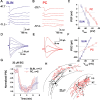GABAergic input onto CA3 hippocampal interneurons remains shunting throughout development
- PMID: 17093093
- PMCID: PMC6674795
- DOI: 10.1523/JNEUROSCI.2887-06.2006
GABAergic input onto CA3 hippocampal interneurons remains shunting throughout development
Abstract
In hippocampus, the net flow of excitability is controlled by inhibitory input provided by the many populations of local circuit inhibitory interneurons. In principal cells, GABA(A) receptor-mediated synaptic input undergoes a highly coordinated shift from depolarizing early in life to a more conventional hyperpolarizing inhibition on maturation. This switch in inhibitory input polarity is controlled by the developmental regulation of two chloride cotransporters (NKCC1 and KCC2) that results in a net shift from high to low intracellular Cl(-). Whether inhibitory input onto inhibitory interneurons demonstrates a similar developmental shift in intracellular Cl(-) is unexplored. Using the gramicidin perforated-patch configuration, we recorded from CA3 hippocampal stratum lucidum interneurons and pyramidal cells to monitor inhibitory input across a broad developmental range. GABA(A) receptor-mediated synaptic input onto stratum lucidum inhibitory interneurons was shunting in nature across the entire developmental age range tested, as resting membrane potential and the IPSC reversal potential remained within a few millivolts (1-4 mV) between postnatal day 5 (P5) and P31. Furthermore, sensitivity to block of the two chloride cotransporters KCC2 and NKCC1 did not differ across the same age range, suggesting that their relative expression is fixed across development. In contrast, pyramidal cell synaptic inhibition demonstrated the well described switch from depolarizing to hyperpolarizing over the same age range. Thus, in contrast to principal cells, inhibitory synaptic input onto CA3 interneurons remains shunting throughout development.
Figures



References
-
- Ben-Ari Y. Excitatory actions of GABA during development: the nature of the nuture. Nat Rev Neurosci. 2002;3:728–739. - PubMed
Publication types
MeSH terms
Substances
Grants and funding
LinkOut - more resources
Full Text Sources
Miscellaneous
